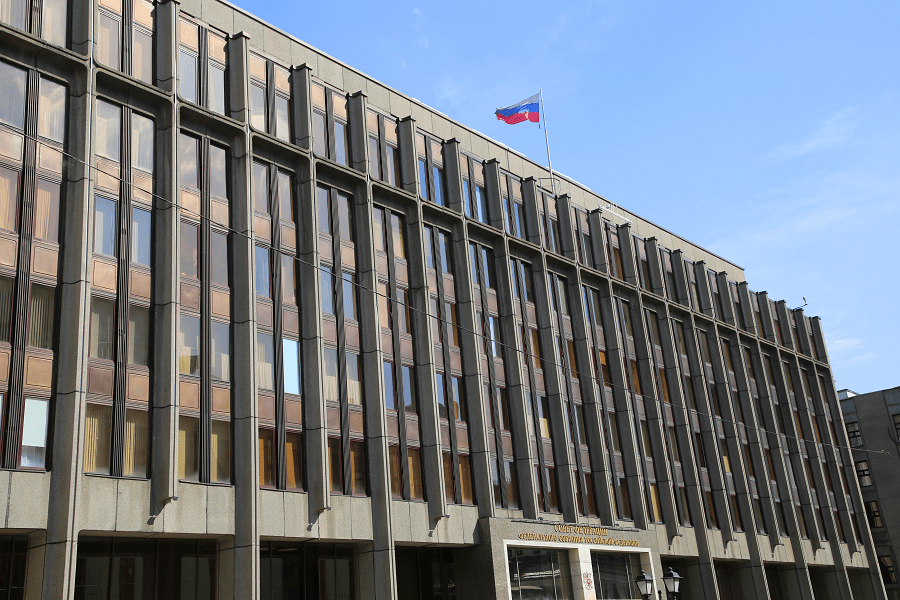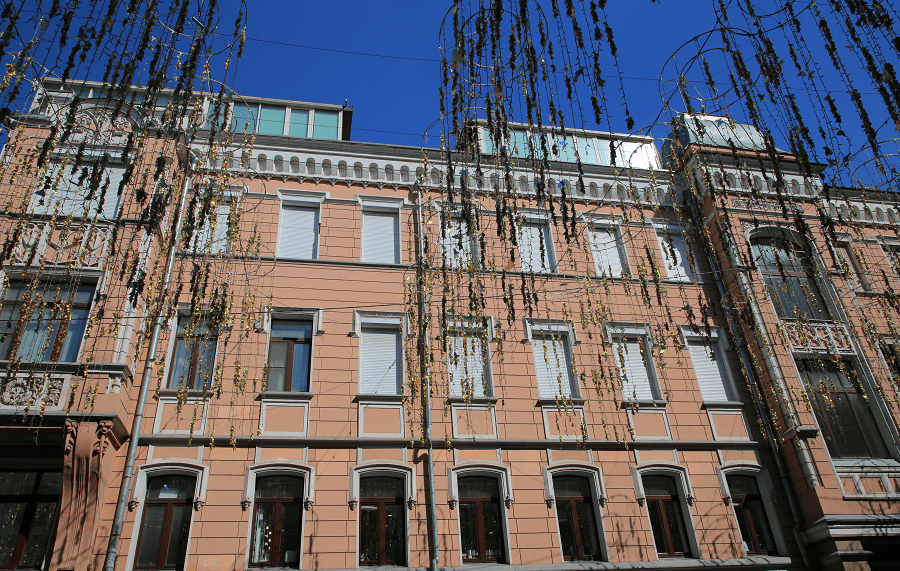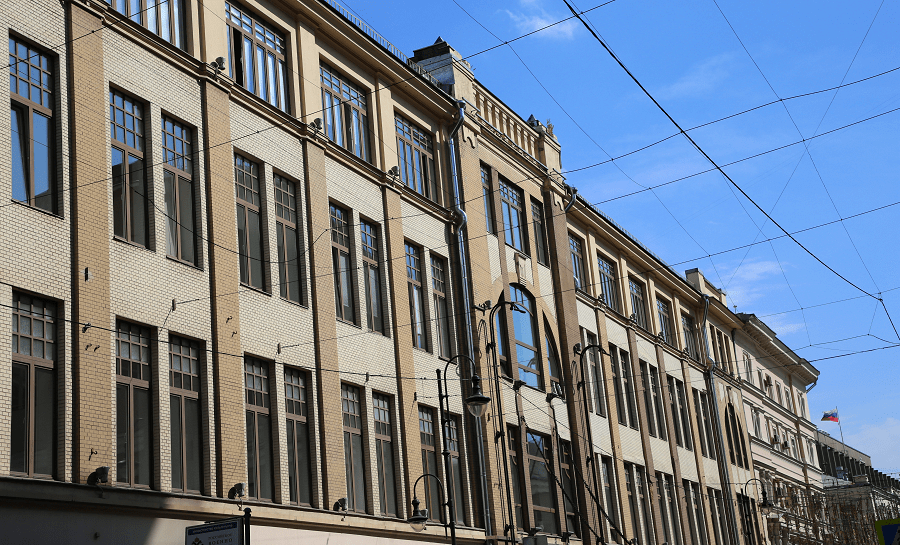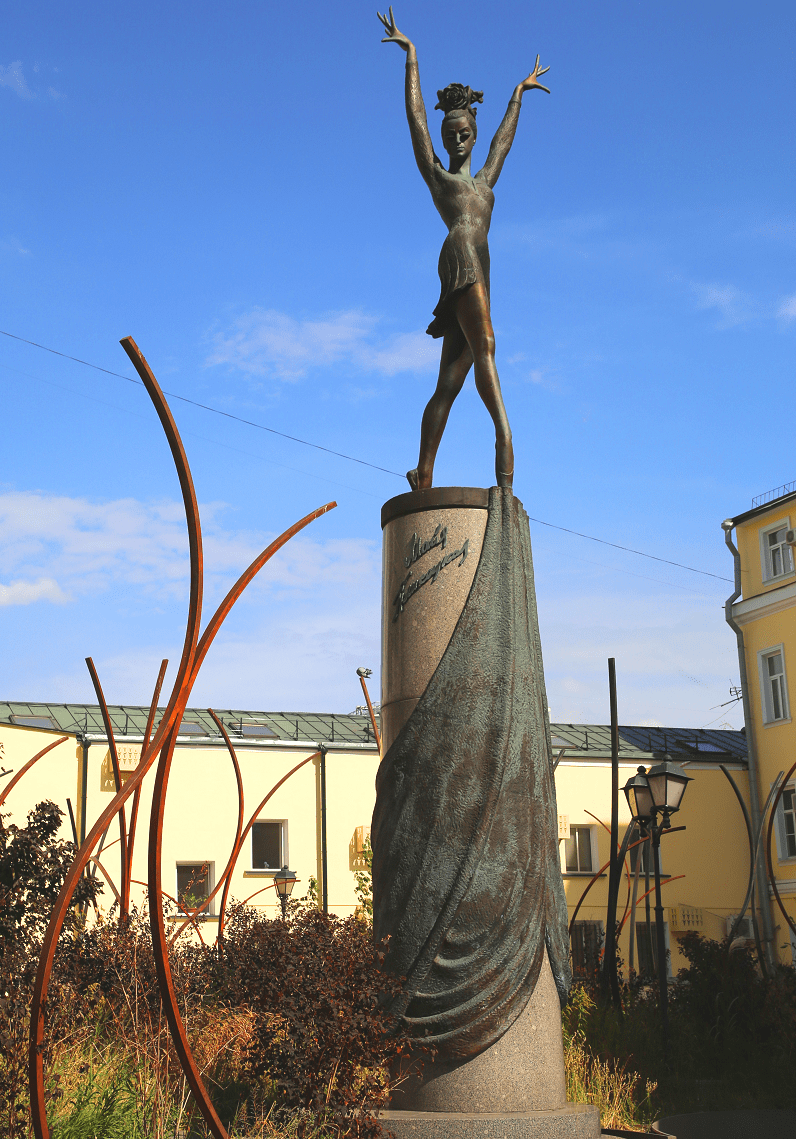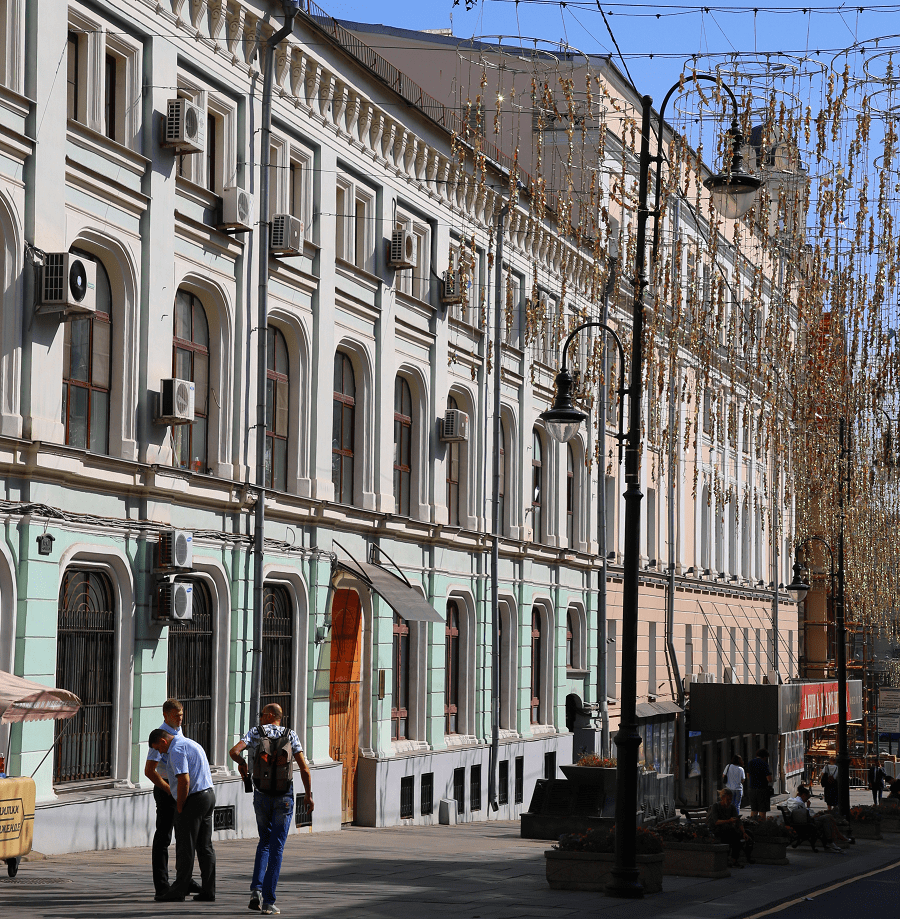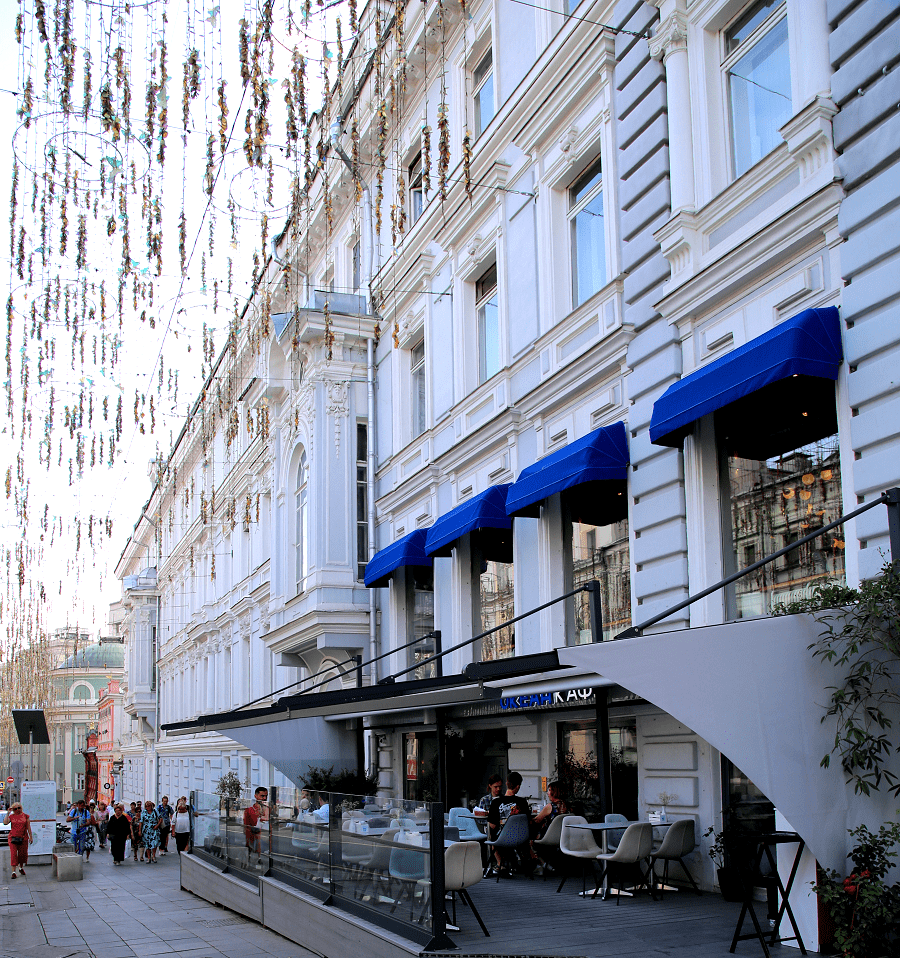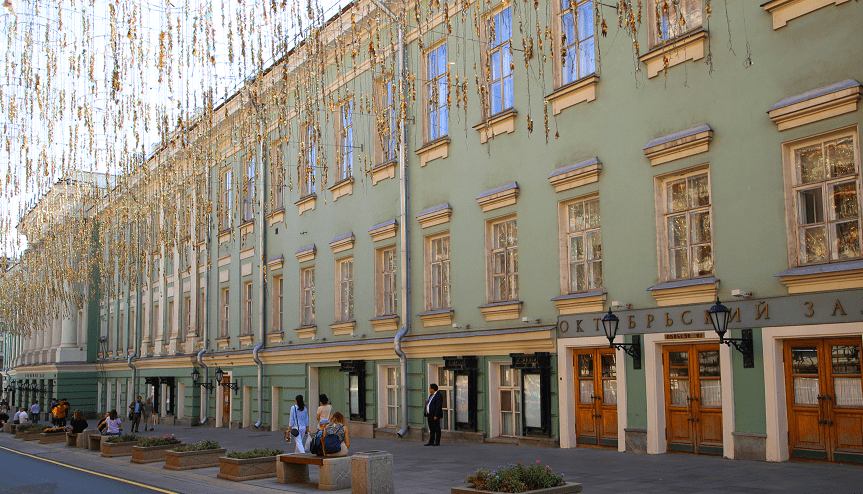Bolshaya Dmitrovka Street (in the early 1920s – Eugene Pottier Street, in 1937-1993 – Pushkinskaya Street) – a street in the Tverskoy district of the Central Administrative District of Moscow. It runs from Okhotny Ryad Street to Strastnoy Boulevard. The numbering of houses begins from Okhotny Ryad street.
The name has been known since the 14th century. It was the road leading to the city of Dimitrov (60 km from Moscow).
Main attractions
On the odd side
House of the Unions (No. 1). After the October Revolution, the building was handed over to the trade unions by decree, after which it received its modern name.
New Manege (No. 3). The “Electric Lighting Society of 1886” designed the building in 1888, making it the first Moscow power station to provide electricity to household consumers. In Soviet times, the building was used as a garage. It has been used as an exhibition building since the 1990s.
Profitable houses of the Synodal Department (No. 5/6). The complex of tenement houses was built in 1898 as part of the project of the architect I. G. Kondratenko.
The complex of tenement houses of E. A. Obukhova and Prince S. S. Obolensky (No. 7/5).
Profitable houses of M. K. Tsyplakova (No. 9). V. Gilyarovsky writes about this house in his work “Moscow and Muscovites.”
Residential building (No. 13). A three-story house, one of the houses on the site of which was the estate of N. N. Muravyov.
RGASPI (No. 15). Russian State Archive of Socio-Political History. Initially, the Lenin Institute, then the Marx-Engels-Lenin-Stalin Institute, then the Central Party Archive of the Institute of Marxism-Leninism under the Central Committee of the CPSU. The first stage with a facade to Sovetskaya (Tverskaya) Square was built between 1925 and 1927. Architect S. E. Chernyshev designed it.
The architect A. N. Fedorov built the Musical Theatre of K. S. Stanislavski and V. I. Nemirovich-Danchenko (No. 17) in 1940 according to the main house of the estate of the Counts Saltykovs that stood here.
The residential building of the People’s Commissariat of Light Industry (No. 21/7) was built in 1935 for workers of the People’s Commissariat of Light Industry as part of the project of architect V.N. Vladimirov. The building is typical of the period of transition of Soviet architecture to the development of the classical heritage: the structure of the house still bears the features of constructivism.
Profitable house of Princess M. A. Liven (No. 23). The richly decorated neoclassical building was designed in 1910 as part of the project of the architect S. V. Barkov. A two-story arched niche above the semicircular bay window of the second and third floors of the Liven apartment building highlights the center of the façade. Above the main entrance is the monogram of the owner in the form of the Latin letter L.
On the even side
The profitable house of K. M. Poltoratsky (No. 2/3) was built in 1821 by the order of K. M. Poltoratsky and by the architect A. F. Elkinsky. It is a valuable city-forming object and has been identified as an object of cultural heritage.
New Stage of the Bolshoi Theater (No. 4/2, p. 2). The building was designed in 1897-1905 by A.F. Meisner for Baron Nostitz on the site of an old house that Major General P.V. Kindyakov owned in the 1820s. Currently – the New Stage of the Bolshoi Theatre.
Solodovnikov Theater (Opera by S. Zimin) (No. 6/2). The estate of the 18th century belonged to the father-in-law of A. V. Suvorov, Prince I. V. Prozorovsky Jr.
City estate of the Myasoyedovs (No. 8/1). At the corner with Kuznetsky Most is the butt of the Myasoedovs’ city estate, the architectural appearance of which was formed in the middle of the 18th – early 19th centuries. In 1829, the main house of the estate was sold to accommodate a theater school and later the Moscow office of the imperial theaters was located there.
No. 12/1. The tenement house of the merchant Zhivago was rebuilt as part of the project of the architect S. S. Eybushits in 1884.
The House of Zalessky and Chaplin (No. 16) in the first half of the 19th century belonged to the Meshchersky princes. In the mid-1840s, the young poet Ya. P. Polonsky lived here. In the second half of the 19th century, the owner of the house was Leopold Stürzwage, who produced grand pianos of the same brand in Moscow.
The Mozgins’ profitable house (No. 20) was built in 1911 according to the design of the architect K. L. Rosenkampf.
House of the Moscow Association for a loan secured by movable property (No. 22). The architect A.V. Ivanov built the five-story house in 1904-1905 and commissioned by order of the Moscow Association for a loan secured by movable property (later – the Private Lombard Joint-Stock Company). The unusual structure of the facade, decorated with three triangular bay windows and shallow arched niches with balconies distinguishes the building.
Federation Council (No. 24 – 26). The complex of buildings of the Federation Council – the upper house of the Federal Assembly (No. 24/1, 24/1a, 24/, 26). It was built in 1983 according to the project of architects I. A. Pokrovsky and Yu. A. Sverdlovsky.
Profitable house of St. Gregory the Theological Church (No. 30/1). The five-storey tenement house of St. Gregory the Theological Church was built in 1888-1894 according to the project of architects L. N. Kekushev and S. I. Tikhomirov (Belarusian) Russian.
Lewisson Trading House (No. 32). The trading house of the furniture maker R. B. Levisson was built in 1901 according to the project of the architect A. E. Erichson, with the participation of his assistant architect A. I. German.
Printing house of Moscow University (No. 34). It was built in 1821-1826 according to the project of the architect D. G. Grigoriev.
Nearest metro: Kuznetsky Most, Lubyanka, Teatralnaya, Ohotny Ryad, Ploschad Revolyutsii, Pushkinskaya.
Attractions around: Bolshoi Theatre, Maly Theatre, Manezhnaya Square, Ploschad Revolyutsii (square), State Duma building, House of the Unions, TSUM, Monument to Alexander Ostrovsky, Tretyakovskiy proezd, Central Children’s Store, Lubyanka Building, Metropol Hotel, Red Square, Tverskaya street, Kremlin.
See more streets and squares in Moscow, monuments of Moscow, architecture of Moscow.





